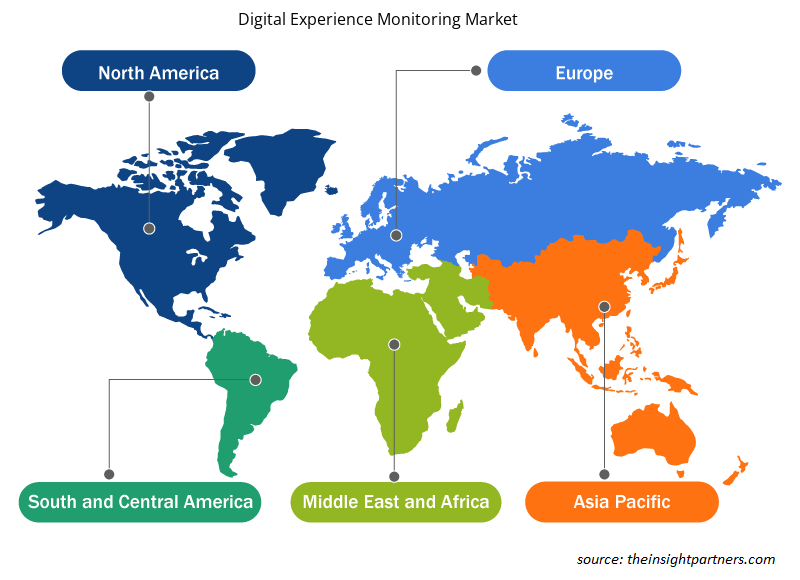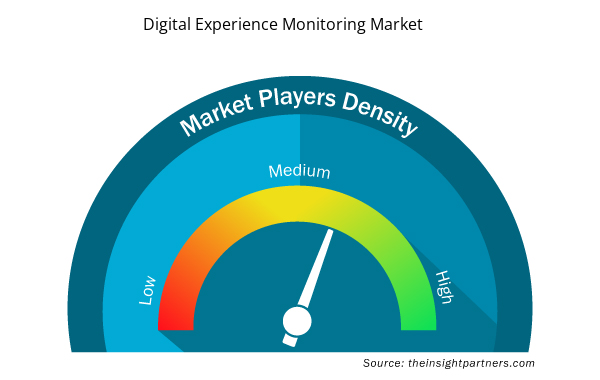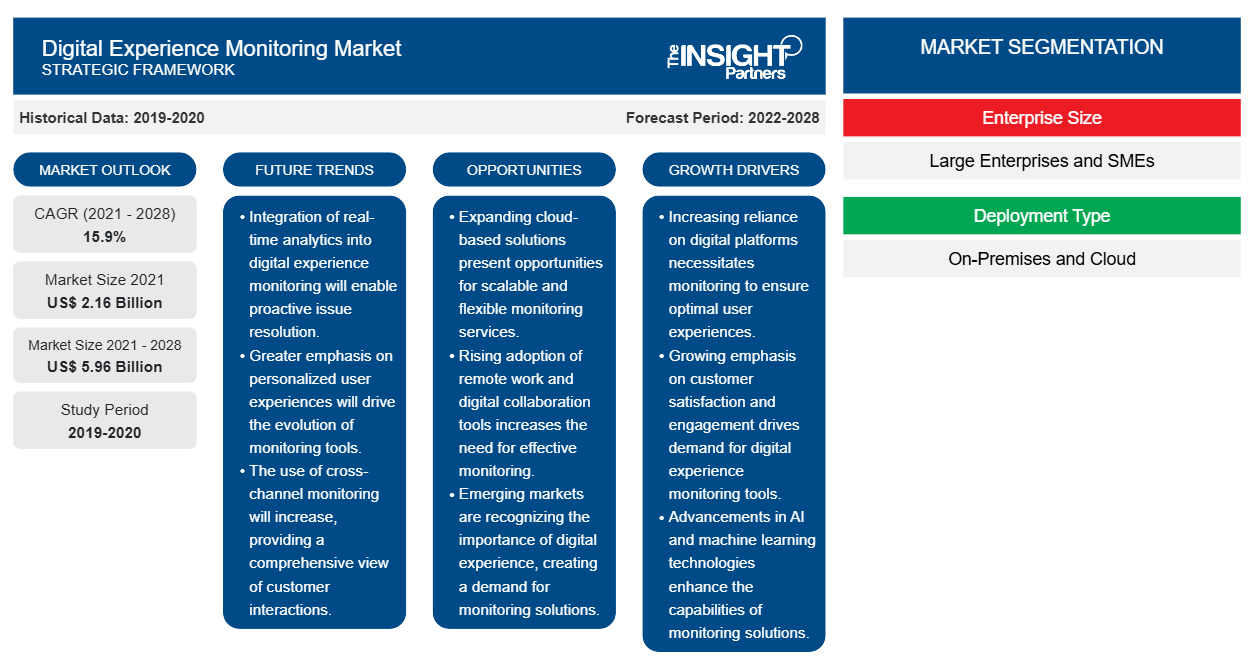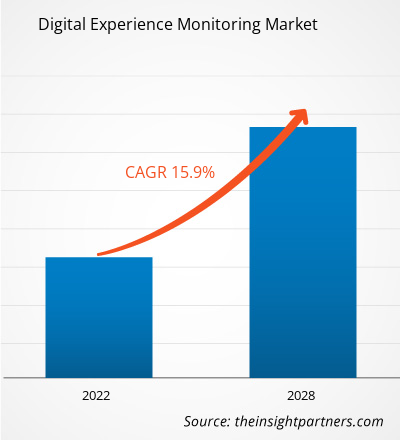数字体验监控市场规模预计将从 2021 年的 21.5671 亿美元增长到 2028 年的 59.6087 亿美元。预计从 2022 年到 2028 年,数字体验监控市场规模的复合年增长率为 15.9%。
数字体验监控 (DEM) 是一项新技术,企业正在将其视为一种简化用户性能问题的方法,同时通过单一解决方案深入了解一系列网络技术。应用程序性能监控(APM) 和最终用户体验监控 (EUEM) 发展成为评估企业应用程序和服务功效的整体解决方案,这就是 DEM。DEM 是一种实时监控解决方案,可帮助 IT 运营团队及时解决用户问题,同时确保网络不受干扰。现有的应用程序性能监控 (APM) 和网络性能监控和诊断 (NPMD) 技术可以通过 DEM 解决方案进行补充。当一起使用时,它们可以提供端到端视图,DEM 可以深入了解用户体验。这些体验对公司成果有最直接的影响。DEM 是一种实时监控工具,它通过发现导致停机或用户体验中断的漏洞(例如糟糕的页面加载时间)并确定性能的根本原因,帮助您公司的“机器”顺利运行。 DEM 软件可监控用户行为、流量和其他因素,帮助企业了解产品的可用性和性能。DEM 产品集成了主动或模拟流量和真实用户监控,以分析理论性能和真实用户体验。这些工具提供了用于检查和改进应用程序和站点性能的分析工具。它们还可以帮助企业了解访问者如何浏览他们的网站,并发现最终用户体验似乎受到影响的地方。
检查设备、应用程序、基础设施和服务的性能数据,以了解最终用户与技术的交互如何影响其数字体验的质量,这被称为 DEM。IT 可以使用数字体验监控来跟踪和评估影响用户的各种参数,包括 CPU、内存、硬件利用率、延迟、软件性能等。这些测量值是从端点不断收集的,并与认知分析和自动化相结合,可以帮助 IT 在用户不知情的情况下及时诊断、补救甚至预测问题。反馈和意见还可以指出端点统计数据无法捕获的元素。数字体验监控解决方案超越了典型的网络和应用程序性能监控,可以发现可能影响基于云的服务性能的网络问题。这一因素正在影响数字体验监控市场的增长。
定制此报告以满足您的需求
您可以免费定制任何报告,包括本报告的部分内容、国家级分析、Excel 数据包,以及为初创企业和大学提供优惠和折扣
- 获取此报告的关键市场趋势。这个免费样品将包括数据分析,从市场趋势到估计和预测。
COVID-19 疫情对数字体验监控市场的影响
随着 COVID-19 疫情的爆发,整个航空业陷入了意外停顿。土耳其、伊朗、南非、伊拉克、以色列、沙特阿拉伯和阿联酋报告了大量 COVID-19 确诊病例和死亡病例。数字体验监控市场包括阿联酋和沙特阿拉伯等主要经济体,由于拥有庞大的多样化客户群,它们是数字体验监控行业的潜在供应商。在疫情爆发之前,海湾国家即将在各个垂直领域采用变革性数字技术,以改善国家的社会经济状况。然而,由于 COVID-19 疫情的爆发,工厂封锁、企业停工和旅行限制等严格措施的实施加剧了 MEA 等国家的经济问题。因此,MEA 的经济状况和 COVID-19 疫情对该地区各行业增长的影响略微影响了 2020 年的数字体验监控市场增长。
数字体验监控市场洞察
由于数字体验监控市场的技术进步,对任何功能齐全且盈利的数字体验监控行业都至关重要的客户反馈系统得到了增强。例如,公司正在使用尖端的客户关系管理(CRM) 实施在线反馈系统。因此,客户输入直接有助于进行实时修改和更新公司的软件,以对质量进行实时评估并根据需要进行调整或更改。任何经历数字化转型的公司都必须实施体验监控系统。简化运营公司所涉及的数字程序为未来的系统变更或持续创新奠定了坚实的基础。这正在推动数字体验监控市场的发展。
基于企业规模的市场洞察
数字体验监控市场按企业规模分析,市场分为大型企业和中小型企业。2021 年,大型企业占据了更大的数字体验监控市场份额。
基于部署类型的市场洞察
数字体验监控市场按部署类型分析,市场分为本地和云。2021 年,云部分占据了更大的数字体验监控市场份额。
参与者采用合并、收购和市场计划等策略来维持其在市场中的地位。以下列出了市场主要参与者的一些发展:
- 2022 年,BMC 宣布了其 BMC AMI(自动化大型机智能)和 BMC Compuware 产品组合中的新功能和集成。这些创新通过在整个 IT 环境中提供更高的数据可视性和基于上下文的洞察力,帮助客户提高服务质量并加速软件交付。
- 2021 年,博通公司收购了 AppNeta,以加强互联网和混合云应用程序的网络性能监控。通过将 AppNeta 的端到端可视性与博通屡获殊荣且久经考验的基础设施和 AIOps 功能相结合,运行最复杂网络的全球最大企业现在可以访问单一事实来源来支持他们的云之旅。
数字体验监控市场区域洞察
Insight Partners 的分析师已详细解释了预测期内影响数字体验监控市场的区域趋势和因素。本节还讨论了北美、欧洲、亚太地区、中东和非洲以及南美和中美洲的数字体验监控市场细分和地理位置。

- 获取数字体验监控市场的区域特定数据
数字体验监测市场报告范围
| 报告属性 | 细节 |
|---|---|
| 2021 年市场规模 | 21.6亿美元 |
| 2028 年市场规模 | 59.6亿美元 |
| 全球复合年增长率(2021 - 2028) | 15.9% |
| 史料 | 2019-2020 |
| 预测期 | 2022-2028 |
| 涵盖的领域 | 按企业规模
|
| 覆盖地区和国家 | 北美
|
| 市场领导者和主要公司简介 |
|
数字体验监控市场参与者密度:了解其对业务动态的影响
数字体验监控市场正在快速增长,这得益于终端用户需求的不断增长,而这些需求又源于消费者偏好的不断变化、技术进步以及对产品优势的认识不断提高等因素。随着需求的增加,企业正在扩大其产品范围,进行创新以满足消费者的需求,并利用新兴趋势,从而进一步推动市场增长。
市场参与者密度是指在特定市场或行业内运营的企业或公司的分布情况。它表明相对于给定市场空间的规模或总市场价值,有多少竞争对手(市场参与者)存在于该市场空间中。
在数字体验监控市场运营的主要公司有:
- AppDynamics有限责任公司
- BMC 软件公司
- 博通公司
- Catchpoint Systems 有限公司
- Dynatrace有限责任公司
免责声明:上面列出的公司没有按照任何特定顺序排列。

- 了解数字体验监控市场顶级关键参与者的概况
数字体验监控市场报告中的公司简介
- BMC 软件公司
- 博通公司
- ControlUp 技术有限公司
- 湖畔软件有限公司
- 艾特里汀有限责任公司
- Nexthink 南非
- AppDynamics有限责任公司
- Catchpoint Systems 有限公司
- Dynatrace有限责任公司
- IBM 公司
- 微焦点
- 甲骨文公司
- Riverbed 科技公司
- 思爱普
- 历史分析(2 年)、基准年、预测(7 年)及复合年增长率
- PEST 和 SWOT 分析
- 市场规模价值/数量 - 全球、区域、国家
- 行业和竞争格局
- Excel 数据集


- EMC Testing Market
- Vision Guided Robotics Software Market
- 3D Mapping and Modelling Market
- Hydrolyzed Collagen Market
- Genetic Testing Services Market
- Pharmacovigilance and Drug Safety Software Market
- Surgical Gowns Market
- Artificial Intelligence in Healthcare Diagnosis Market
- Formwork System Market
- Point of Care Diagnostics Market

Report Coverage
Revenue forecast, Company Analysis, Industry landscape, Growth factors, and Trends

Segment Covered
This text is related
to segments covered.

Regional Scope
North America, Europe, Asia Pacific, Middle East & Africa, South & Central America

Country Scope
This text is related
to country scope.
常见问题
The major five companies in the digital experience monitoring market include BMC Software, Inc.; Broadcom Inc.; AppDynamics LLC; Dynatrace LLC; and IBM Corporation.
On the basis of end user, the digital experience monitoring market is segmented into BFSI, IT and telecommunications, retail and consumer goods, healthcare and life sciences and life sciences, and others. In 2021, the BFSI segment led the digital experience monitoring market, accounting for the largest share in the market.
In 2021, North America led the market with a substantial revenue share, followed by Europe and APAC. North America is a prospective market for digital experience monitoring developers.
Based on enterprise size, the digital experience monitoring market is bifurcated into large enterprises and SMEs. In 2021, the large enterprises segment led the digital experience monitoring market, accounting for the largest share in the market. Further, small and medium enterprises (SMEs) are companies with revenues, assets, or personnel that fall below a particular threshold. A small and medium enterprises (SME) is defined differently in each country. Small and medium enterprises (SMEs) play a vital role in the economy, despite their small size. They outnumber major corporations by a substantial margin, employ a huge workforce, and are entrepreneurial in nature, contributing to the shaping of innovation.
Demand for better end-user experience and adoption of cutting-edge technologies are driving the growth of the digital experience monitoring market.
The market opportunity lies in developing countries. Developing countries have become a hub of opportunity for various markets, including the digital experience monitoring market. Further, adoption of AI & IoT in fintech business is presenting significant potential for the future growth of the digital experience monitoring market players.
Trends and growth analysis reports related to Technology, Media and Telecommunications : READ MORE..
The List of Companies - Digital Experience Monitoring Market
- AppDynamics LLC
- BMC Software, Inc.
- Broadcom Inc.
- Catchpoint Systems, inc.
- Dynatrace LLC
- IBM Corporation
- Micro Focus
- Oracle Corporation
- Riverbed Technology, Inc.
- SAP SE
- ControlUp Technologies LTD
- Lakeside Software, LLC
- Aternity LLC
- Nexthink SA
The Insight Partners performs research in 4 major stages: Data Collection & Secondary Research, Primary Research, Data Analysis and Data Triangulation & Final Review.
- Data Collection and Secondary Research:
As a market research and consulting firm operating from a decade, we have published and advised several client across the globe. First step for any study will start with an assessment of currently available data and insights from existing reports. Further, historical and current market information is collected from Investor Presentations, Annual Reports, SEC Filings, etc., and other information related to company’s performance and market positioning are gathered from Paid Databases (Factiva, Hoovers, and Reuters) and various other publications available in public domain.
Several associations trade associates, technical forums, institutes, societies and organization are accessed to gain technical as well as market related insights through their publications such as research papers, blogs and press releases related to the studies are referred to get cues about the market. Further, white papers, journals, magazines, and other news articles published in last 3 years are scrutinized and analyzed to understand the current market trends.
- Primary Research:
The primarily interview analysis comprise of data obtained from industry participants interview and answers to survey questions gathered by in-house primary team.
For primary research, interviews are conducted with industry experts/CEOs/Marketing Managers/VPs/Subject Matter Experts from both demand and supply side to get a 360-degree view of the market. The primary team conducts several interviews based on the complexity of the markets to understand the various market trends and dynamics which makes research more credible and precise.
A typical research interview fulfils the following functions:
- Provides first-hand information on the market size, market trends, growth trends, competitive landscape, and outlook
- Validates and strengthens in-house secondary research findings
- Develops the analysis team’s expertise and market understanding
Primary research involves email interactions and telephone interviews for each market, category, segment, and sub-segment across geographies. The participants who typically take part in such a process include, but are not limited to:
- Industry participants: VPs, business development managers, market intelligence managers and national sales managers
- Outside experts: Valuation experts, research analysts and key opinion leaders specializing in the electronics and semiconductor industry.
Below is the breakup of our primary respondents by company, designation, and region:

Once we receive the confirmation from primary research sources or primary respondents, we finalize the base year market estimation and forecast the data as per the macroeconomic and microeconomic factors assessed during data collection.
- Data Analysis:
Once data is validated through both secondary as well as primary respondents, we finalize the market estimations by hypothesis formulation and factor analysis at regional and country level.
- Macro-Economic Factor Analysis:
We analyse macroeconomic indicators such the gross domestic product (GDP), increase in the demand for goods and services across industries, technological advancement, regional economic growth, governmental policies, the influence of COVID-19, PEST analysis, and other aspects. This analysis aids in setting benchmarks for various nations/regions and approximating market splits. Additionally, the general trend of the aforementioned components aid in determining the market's development possibilities.
- Country Level Data:
Various factors that are especially aligned to the country are taken into account to determine the market size for a certain area and country, including the presence of vendors, such as headquarters and offices, the country's GDP, demand patterns, and industry growth. To comprehend the market dynamics for the nation, a number of growth variables, inhibitors, application areas, and current market trends are researched. The aforementioned elements aid in determining the country's overall market's growth potential.
- Company Profile:
The “Table of Contents” is formulated by listing and analyzing more than 25 - 30 companies operating in the market ecosystem across geographies. However, we profile only 10 companies as a standard practice in our syndicate reports. These 10 companies comprise leading, emerging, and regional players. Nonetheless, our analysis is not restricted to the 10 listed companies, we also analyze other companies present in the market to develop a holistic view and understand the prevailing trends. The “Company Profiles” section in the report covers key facts, business description, products & services, financial information, SWOT analysis, and key developments. The financial information presented is extracted from the annual reports and official documents of the publicly listed companies. Upon collecting the information for the sections of respective companies, we verify them via various primary sources and then compile the data in respective company profiles. The company level information helps us in deriving the base number as well as in forecasting the market size.
- Developing Base Number:
Aggregation of sales statistics (2020-2022) and macro-economic factor, and other secondary and primary research insights are utilized to arrive at base number and related market shares for 2022. The data gaps are identified in this step and relevant market data is analyzed, collected from paid primary interviews or databases. On finalizing the base year market size, forecasts are developed on the basis of macro-economic, industry and market growth factors and company level analysis.
- Data Triangulation and Final Review:
The market findings and base year market size calculations are validated from supply as well as demand side. Demand side validations are based on macro-economic factor analysis and benchmarks for respective regions and countries. In case of supply side validations, revenues of major companies are estimated (in case not available) based on industry benchmark, approximate number of employees, product portfolio, and primary interviews revenues are gathered. Further revenue from target product/service segment is assessed to avoid overshooting of market statistics. In case of heavy deviations between supply and demand side values, all thes steps are repeated to achieve synchronization.
We follow an iterative model, wherein we share our research findings with Subject Matter Experts (SME’s) and Key Opinion Leaders (KOLs) until consensus view of the market is not formulated – this model negates any drastic deviation in the opinions of experts. Only validated and universally acceptable research findings are quoted in our reports.
We have important check points that we use to validate our research findings – which we call – data triangulation, where we validate the information, we generate from secondary sources with primary interviews and then we re-validate with our internal data bases and Subject matter experts. This comprehensive model enables us to deliver high quality, reliable data in shortest possible time.


 获取此报告的免费样本
获取此报告的免费样本